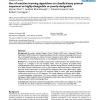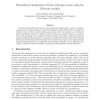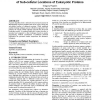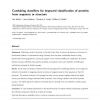20 search results - page 1 / 4 » Use of machine learning algorithms to classify binary protei... |
BMCBI
2008
13 years 4 months ago
2008
Background: By using a standard Support Vector Machine (SVM) with a Sequential Minimal Optimization (SMO) method of training, Na
JBCB
2010
12 years 11 months ago
2010
Protein function prediction is an active area of research in bioinformatics. And yet, transfer of annotation on the basis of sequence or structural similarity remains widely used ...
GECCO
2008
Springer
13 years 5 months ago
2008
Springer
A genetic algorithm (GA) is utilised to discover known and novel PROSITE-like sequence templates that can be used to classify the sub-cellular location of eukaryotic proteins. Whi...
BMCBI
2008
13 years 4 months ago
2008
Background: Predicting a protein's structural or functional class from its amino acid sequence or structure is a fundamental problem in computational biology. Recently, there...
BMCBI
2008
13 years 4 months ago
2008
Background: Prediction of disulfide bridges from protein sequences is useful for characterizing structural and functional properties of proteins. Several methods based on differen...




